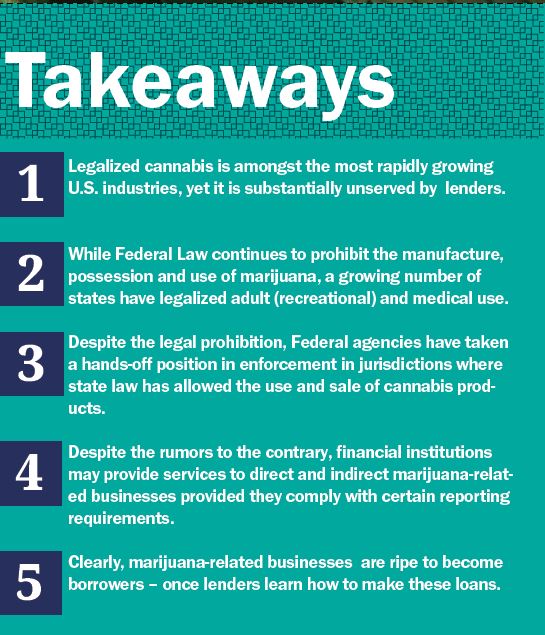- Truist Announces New Head of Structured Credit
- Lendscape Appoints Brett Promisel as Chief Executive Officer
- Receivables Purchase and Asset-Based Lending: Insights from First Brands: Part 2
- Siena Lending Group Transacted over $1B in Facilities in 2025
- Receivables Purchase and Asset-Based Lending: Insights from First Brands
Is Cannabis Lending In Your Future?
By Jeffrey A. Wurst and Paul J. Cambridge

Armstrong Teasdale partners provide lenders with up-to-date information on the complexities of lending to the legalized marijuana industry.
Perhaps the most frequently asked question by growth-oriented lenders is “How and when can we lend into the rapidly growing and already major industry of legalized marijuana?”
The answer is: “It is not so simple.”
It is estimated that U.S. sales of legal marijuana exceeded $15 billion in 2020 (up from about $10 billion in 2019), $2 billion of which came from Colorado alone. These numbers are projected to double by 2024. The legal marijuana industry is certainly escalating, but roadblocks remain, making it difficult to lend to cannabis related businesses.
Let’s start with a review of the state of the law. There is a cacophony of state and federal laws, many of which are at odds with each other. As of this writing, medical marijuana is legal in 35 states and Washington, D.C., while 15 of these states plus Washington, D.C., have legalized adult-use (recreational) marijuana.
Federal Law
Since 1970, with the enactment of the Controlled Substances Act (CSA), the manufacture, possession or use of marijuana – even the use of marijuana for medical purposes – has been prohibited. The Money Laundering Control Act of 1986 imposed harsh penalties (fines and/or imprisonment) upon those who knowingly conducted financial transactions that involved proceeds of any unlawful activity. But, as early as August 2013, the Department of Justice (DOJ) by then-Deputy Attorney General, James Cole, in what has been referred to as the Cole Memorandum took an official hands-off policy suggesting that the U.S. Attorneys refrain from prosecuting state-authorized marijuana use provided that such use does not interfere with certain federal law enforcement. That policy, however, was rescinded in January 2018 by then-Attorney General Jeff Sessions. Prior to that, Congress adopted the Rohrabacher-Farr Amendment, which prohibited the DOJ from using federal funds to prevent implementation of state laws authorizing the use, distribution, possession or cultivation of medical marijuana.
In February 2014, the Financial Crimes Enforcement Network (FinCEN) issued guidance to clarify the Bank Secrecy Act (BSA) expectations for financial institutions providing services to marijuana-related businesses (MRBs). The FinCEN guidance relies heavily on the Cole Memorandum, despite it being rescinded. The FinCEN guidance is the only offi cial federal guidance available to financial institutions regarding marijuana banking. The FinCEN guidance has two key areas of focus: (1) customer diligence and (2) suspicious activity report (SAR) filing.
As a result, when entering into a relationship with a company engaged in an MRB, financial institutions are obligated to conduct substantial customer due diligence to verify that the MRB is in compliance with state law and that there is no indicia of violations of federal law as described in the Cole Memorandum. This due diligence must continue throughout the relationship – not just at the beginning. As a result, there is a significant cost to the f nancial institution in accepting MRBs as customers.
In September 2019, the House of Representatives passed the Secure and Fair Enforcement (SAFE) Banking Act, which, if enacted, prohibits regulators from penalizing depository institutions for providing banking services to state-authorized MRBs. However, the Senate has not taken any action on the SAFE Banking Act.
In December 2020, the House approved the Marijuana Opportunity Reinvestment and Expungement (MORE) Act of 2020, which, if enacted, would remove marijuana from the list of controlled substances and eliminate criminal penalties for the manufacturing, distribution or possession of marijuana. Ancillary parts of the MORE Act include a 5% federal tax on cannabis products. The bill was referred to the Senate, but no action has been taken as of the writing of this article.
In light of change in control of the Senate, one may expect significant changes in the area of federal marijuana law which could, in fact, be the game changer for which lenders have been waiting.

State Laws
Fifteen states and Washington, D.C., have enacted laws legalizing adult recreational as well as medical use of marijuana and 21 states have legalized the use of medical marijuana. Fourteen of the states that have legalized use of medical marijuana plus Washington, D.C., have done away with jail time for possession, of small amounts, and two states that have not legalized recreational or medical use have removed jail time for possessing, small amounts. That leaves 12 states that have not legalized marijuana where jail time may be imposed for possession of even small amounts of marijuana for medicinal purposes.
States have been moved to adopt marijuana laws as a result of public pressure, the medical benefits attributed to cannabis products and especially the economic growth that comes along with it – including the tax revenues.
Banking Services to MRBs
Since 2014, FinCEN has been monitoring depository institutions actively providing banking services to MRBs based on the filing of SARs. While there was a sharp increase in such numbers during 2019, those numbers slightly declined in 2020. This is likely the result of MRBs closing due to pandemic restrictions on business operations, in general, as well as staffing reductions at depository institutions causing delays in the filing of SARs. As of September 2020, there were 677 depository institutions reporting SARs related to MRBs, a drop from 747 less than a year earlier.
We are likely at the cusp of the opportunity to enter into the marijuana lending business, providing lenders are prepared to invest in the infrastructure necessary to comply with FinCEN requirements. That infrastructure needs to be in place to monitor and report on MRB customers and may be shared by both internal and external sources.
It must be understood that MRBs come in different sizes and shapes. Unfortunately, the FinCEN guidance does not provide a comprehensive definition of what is considered an MRB for purposes of the enhanced due diligence and SAR requirements under BSA. Many financial institutions and lenders take a three-tiered approach to providing financial services to direct and indirect MRBs, with the most scrutiny applied to customers in the higher tiers.
- Tier I MRBs include growers, processors, wholesalers and dispensaries – entities that are hands-on with the cannabis products. These are the riskiest customers from a BSA compliance standpoint and the requirements of the FinCEN guidance clearly apply.
- Tier II MRBs are indirect MRBs that receive a significant portion of their revenue from Tier MRBs, including suppliers, security and licensing consultants focused on the marijuana industry.
- And Tier III includes those that do incidental business with MRBs, such as landlords, professional service firms, banks, etc.
The FinCEN guidance indicates that for indirect MRBs, such as thosein Tier II and III, the marijuana-specific SAR requirements of the FinCEN guidance do not apply and it is left to every financial institution or lender to make a risk-based decision whether it will take on those indirect MRBs as customers.
In addition to the BSA compliance costs and risks associated with providing financial services to MRBs, a lender should consider the unique standing of MRBs, given the disconnect between federal and state law when underwriting and structuring loans. For example, when determining appropriate collateral for a loan to an MRB, a lender should consider what would happen if its customer ran into regulatory issues with its state-licensing body or federal law enforcement, including the potential effect of seizure laws if an MRB is ever charged with a crime. Also, a lender should consider how it would take possession of collateral in an event of default given that many states have complex regulatory regimes that only allow licensed business to legally operate as an MRB.
Before lending to an MRB, it is necessary to be familiar with the marijuana laws of the borrower’s state. For example, some states prohibit the granting of security interests in Tier I products. Even if granting a security interest is legally permissible under applicable state law, taking possession of collateral may not be feasible for a lender if it is not licensed as an MRB by the state.
We should be in agreement that it is just a matter of time before MRBs will become a major industry serviced by lenders – both banks and commercial finance companies. Those looking to enter this market are advised to start preparing for this influx of business if they are willing to venture into it. It remains uncertain when, if ever, the diligence and reporting requirements will ease and make MRB borrowers more akin to others that are not regulated; however, it is unlikely that will be soon. Thus, lenders anxious to enter the MRB marketplace are advised to be prepared to take on the reporting requirements and to price their loan products accordingly.

.jpg?sfvrsn=f1093d2a_0)
